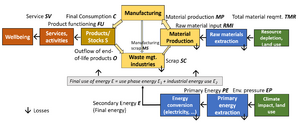STYLIE: Difference between revisions
(Created page with "== General Scope and Connection with Climate Mitigation == === Introduction === Provide context and general introduction to the model. A visual representation of the model would be great (can also be added in the next section). === Model Scope === Add the scope of the model. Geographical, Time, Decision, Sectors, Materials, Products. === Model Development === * Status: * Environment: * Documentation: * Source code: == Circular Economy Features == This section pro...") |
(Added first desription) |
||
| Line 3: | Line 3: | ||
=== Introduction === | === Introduction === | ||
STYLIE (from Stylistic industial ecology (IE) model) is a simple accounting tool to capture the major service flows, product stocks, and energy and material flows in a circular economy. It has a comprehensive scope, as it links service provision (a major constituent of human wellbeing) with envionmental pressures (such as resource extraction and climate impact). It's system definition, which is based on the concept of the energy service cascade is shown below. | |||
[[File:STYLIE 1.png|thumb|Figure: System definition of the STYLIE accounting model.]] | |||
=== Model Scope === | === Model Scope === | ||
STYLIE can be applied at any geographical, service sector, and material scale. As an accounting model, it does not generate new results, but uses results from existing scenarios to develop a set of indicators and show where in the energy service cascade the decoupling happens. | |||
=== Model Development === | === Model Development === | ||
Revision as of 14:37, 31 May 2023
General Scope and Connection with Climate Mitigation
Introduction
STYLIE (from Stylistic industial ecology (IE) model) is a simple accounting tool to capture the major service flows, product stocks, and energy and material flows in a circular economy. It has a comprehensive scope, as it links service provision (a major constituent of human wellbeing) with envionmental pressures (such as resource extraction and climate impact). It's system definition, which is based on the concept of the energy service cascade is shown below.
Model Scope
STYLIE can be applied at any geographical, service sector, and material scale. As an accounting model, it does not generate new results, but uses results from existing scenarios to develop a set of indicators and show where in the energy service cascade the decoupling happens.
Model Development
- Status:
- Environment:
- Documentation:
- Source code:
Circular Economy Features
This section provide the CE features of the model
R Words coverage and implemented in the model
CE strategies and connection with climate change mitigation.
Synergies and trade-off between the R word in the context of the stylized model
Insights for Analytical Framework
This section should highlight the features relevant for the CIRCOMOD analytical framework. They should be linked with the previous section which provide more details.
- Key mechanisms and interactions within CE strategies that lead to changes in GHG emissions.
- Tool exploration (demonstrating ideas before implementing them in large-scale quantitative models)
- Communication key CE dynamics (to the broader audience)
Refinement, Integration, Future Development
The following sections are optional and should be completed only if they are relevant.
Refinement process
Please describe how the stylized model will be improved/refined in the CIRCOMOD project.
Integration
Highlight the features to be integrated in larger model in the CIRCOMOD project.
Future features of the model
Not yet implemented, planned model developments, if any.

